Business Operations Case Study: Tesco Plc and Strategic Decisions
VerifiedAdded on 2023/01/04
|8
|2446
|30
Case Study
AI Summary
This case study examines the business operations of Tesco Plc, a multinational retailer. It begins with an introduction to business operations, defining key activities aimed at maximizing profit and value. The case study provides an overview of Tesco, including its founding, global presence, and diverse operations in general merchandise and groceries. The main body delves into the functions of business operations, such as marketing, finance, human resources, and production, and how they apply to Tesco. It also evaluates Tesco's operations management decisions, particularly in response to the accounting scandal and its impact on share prices. The evaluation covers areas like production, supply chain, logistics, location strategies, quality control, and human resources, highlighting the importance of strategic decisions in these areas to overcome challenges and maintain a competitive edge. The report concludes by emphasizing the importance of effective business operations and strategic decision-making for achieving organizational objectives and sustained success.
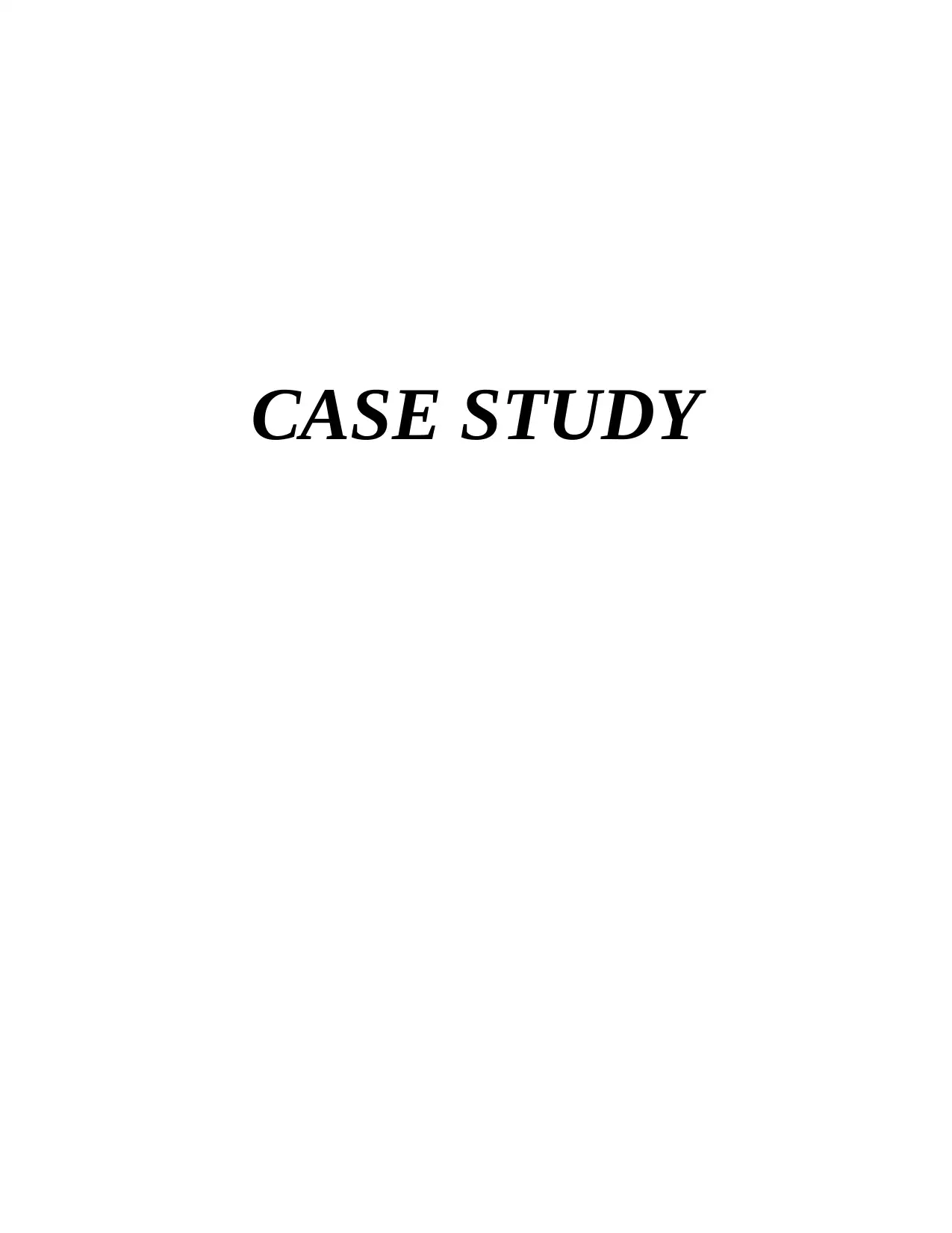
CASE STUDY
Paraphrase This Document
Need a fresh take? Get an instant paraphrase of this document with our AI Paraphraser
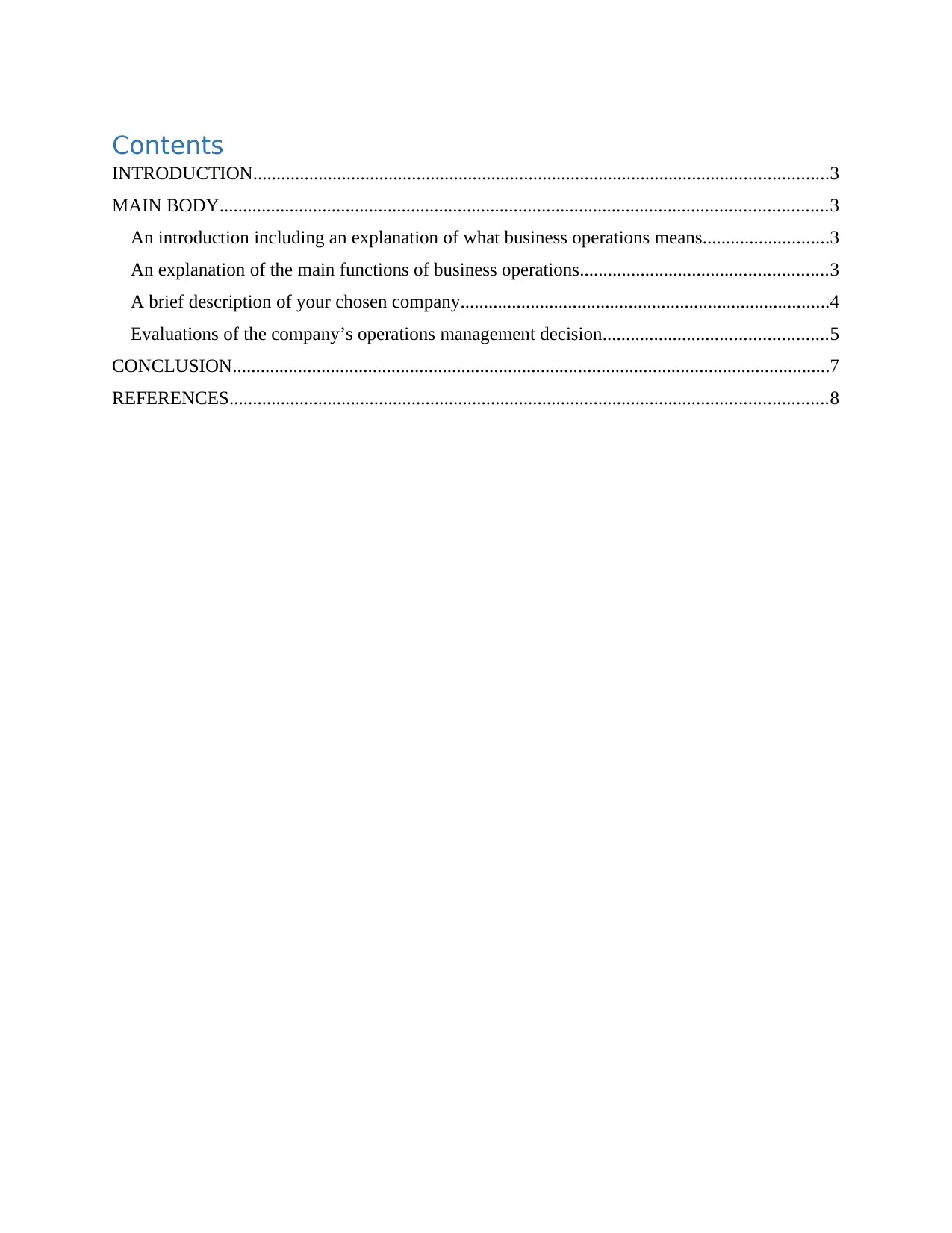
Contents
INTRODUCTION...........................................................................................................................3
MAIN BODY..................................................................................................................................3
An introduction including an explanation of what business operations means...........................3
An explanation of the main functions of business operations.....................................................3
A brief description of your chosen company...............................................................................4
Evaluations of the company’s operations management decision................................................5
CONCLUSION................................................................................................................................7
REFERENCES................................................................................................................................8
INTRODUCTION...........................................................................................................................3
MAIN BODY..................................................................................................................................3
An introduction including an explanation of what business operations means...........................3
An explanation of the main functions of business operations.....................................................3
A brief description of your chosen company...............................................................................4
Evaluations of the company’s operations management decision................................................5
CONCLUSION................................................................................................................................7
REFERENCES................................................................................................................................8
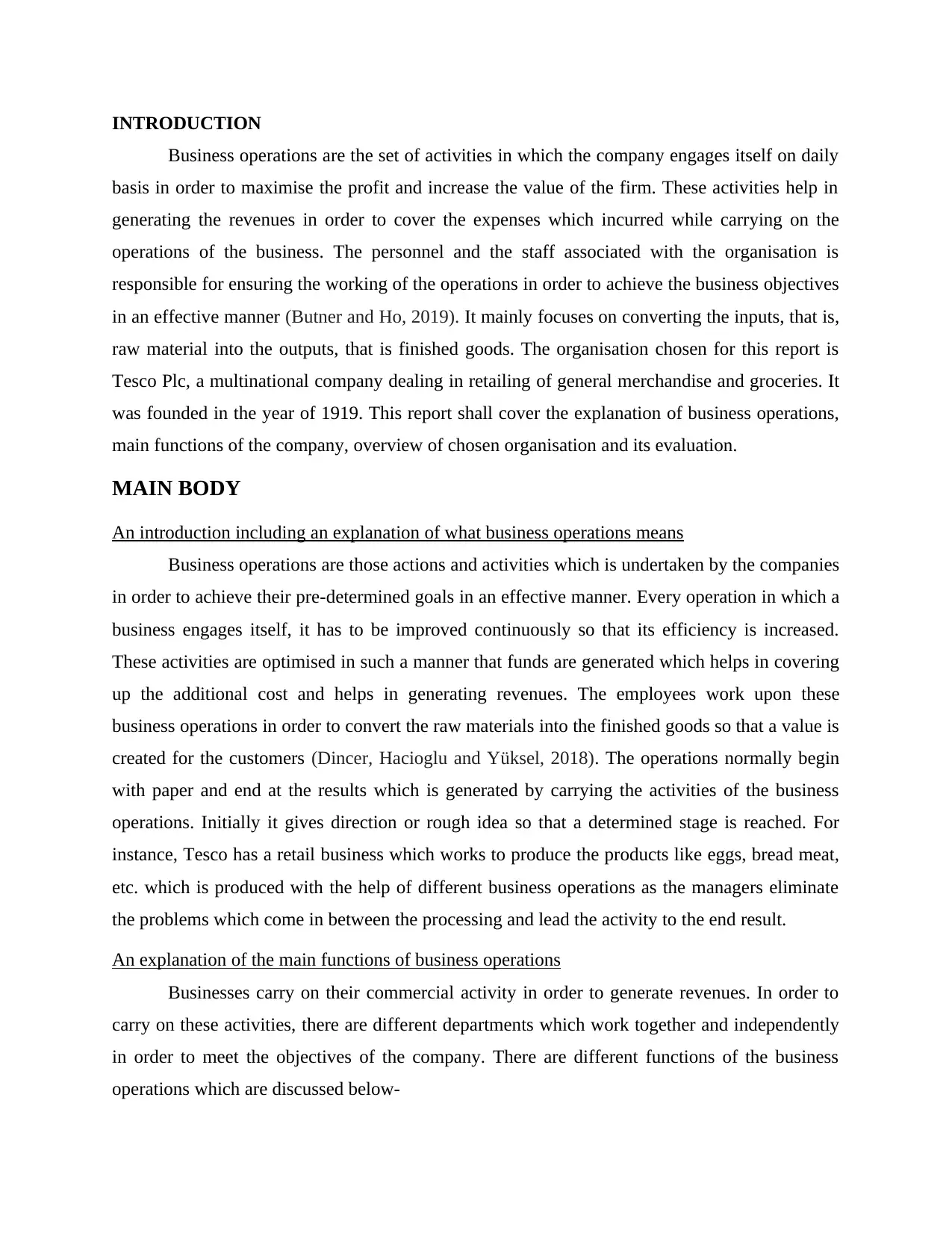
INTRODUCTION
Business operations are the set of activities in which the company engages itself on daily
basis in order to maximise the profit and increase the value of the firm. These activities help in
generating the revenues in order to cover the expenses which incurred while carrying on the
operations of the business. The personnel and the staff associated with the organisation is
responsible for ensuring the working of the operations in order to achieve the business objectives
in an effective manner (Butner and Ho, 2019). It mainly focuses on converting the inputs, that is,
raw material into the outputs, that is finished goods. The organisation chosen for this report is
Tesco Plc, a multinational company dealing in retailing of general merchandise and groceries. It
was founded in the year of 1919. This report shall cover the explanation of business operations,
main functions of the company, overview of chosen organisation and its evaluation.
MAIN BODY
An introduction including an explanation of what business operations means
Business operations are those actions and activities which is undertaken by the companies
in order to achieve their pre-determined goals in an effective manner. Every operation in which a
business engages itself, it has to be improved continuously so that its efficiency is increased.
These activities are optimised in such a manner that funds are generated which helps in covering
up the additional cost and helps in generating revenues. The employees work upon these
business operations in order to convert the raw materials into the finished goods so that a value is
created for the customers (Dincer, Hacioglu and Yüksel, 2018). The operations normally begin
with paper and end at the results which is generated by carrying the activities of the business
operations. Initially it gives direction or rough idea so that a determined stage is reached. For
instance, Tesco has a retail business which works to produce the products like eggs, bread meat,
etc. which is produced with the help of different business operations as the managers eliminate
the problems which come in between the processing and lead the activity to the end result.
An explanation of the main functions of business operations
Businesses carry on their commercial activity in order to generate revenues. In order to
carry on these activities, there are different departments which work together and independently
in order to meet the objectives of the company. There are different functions of the business
operations which are discussed below-
Business operations are the set of activities in which the company engages itself on daily
basis in order to maximise the profit and increase the value of the firm. These activities help in
generating the revenues in order to cover the expenses which incurred while carrying on the
operations of the business. The personnel and the staff associated with the organisation is
responsible for ensuring the working of the operations in order to achieve the business objectives
in an effective manner (Butner and Ho, 2019). It mainly focuses on converting the inputs, that is,
raw material into the outputs, that is finished goods. The organisation chosen for this report is
Tesco Plc, a multinational company dealing in retailing of general merchandise and groceries. It
was founded in the year of 1919. This report shall cover the explanation of business operations,
main functions of the company, overview of chosen organisation and its evaluation.
MAIN BODY
An introduction including an explanation of what business operations means
Business operations are those actions and activities which is undertaken by the companies
in order to achieve their pre-determined goals in an effective manner. Every operation in which a
business engages itself, it has to be improved continuously so that its efficiency is increased.
These activities are optimised in such a manner that funds are generated which helps in covering
up the additional cost and helps in generating revenues. The employees work upon these
business operations in order to convert the raw materials into the finished goods so that a value is
created for the customers (Dincer, Hacioglu and Yüksel, 2018). The operations normally begin
with paper and end at the results which is generated by carrying the activities of the business
operations. Initially it gives direction or rough idea so that a determined stage is reached. For
instance, Tesco has a retail business which works to produce the products like eggs, bread meat,
etc. which is produced with the help of different business operations as the managers eliminate
the problems which come in between the processing and lead the activity to the end result.
An explanation of the main functions of business operations
Businesses carry on their commercial activity in order to generate revenues. In order to
carry on these activities, there are different departments which work together and independently
in order to meet the objectives of the company. There are different functions of the business
operations which are discussed below-
⊘ This is a preview!⊘
Do you want full access?
Subscribe today to unlock all pages.

Trusted by 1+ million students worldwide
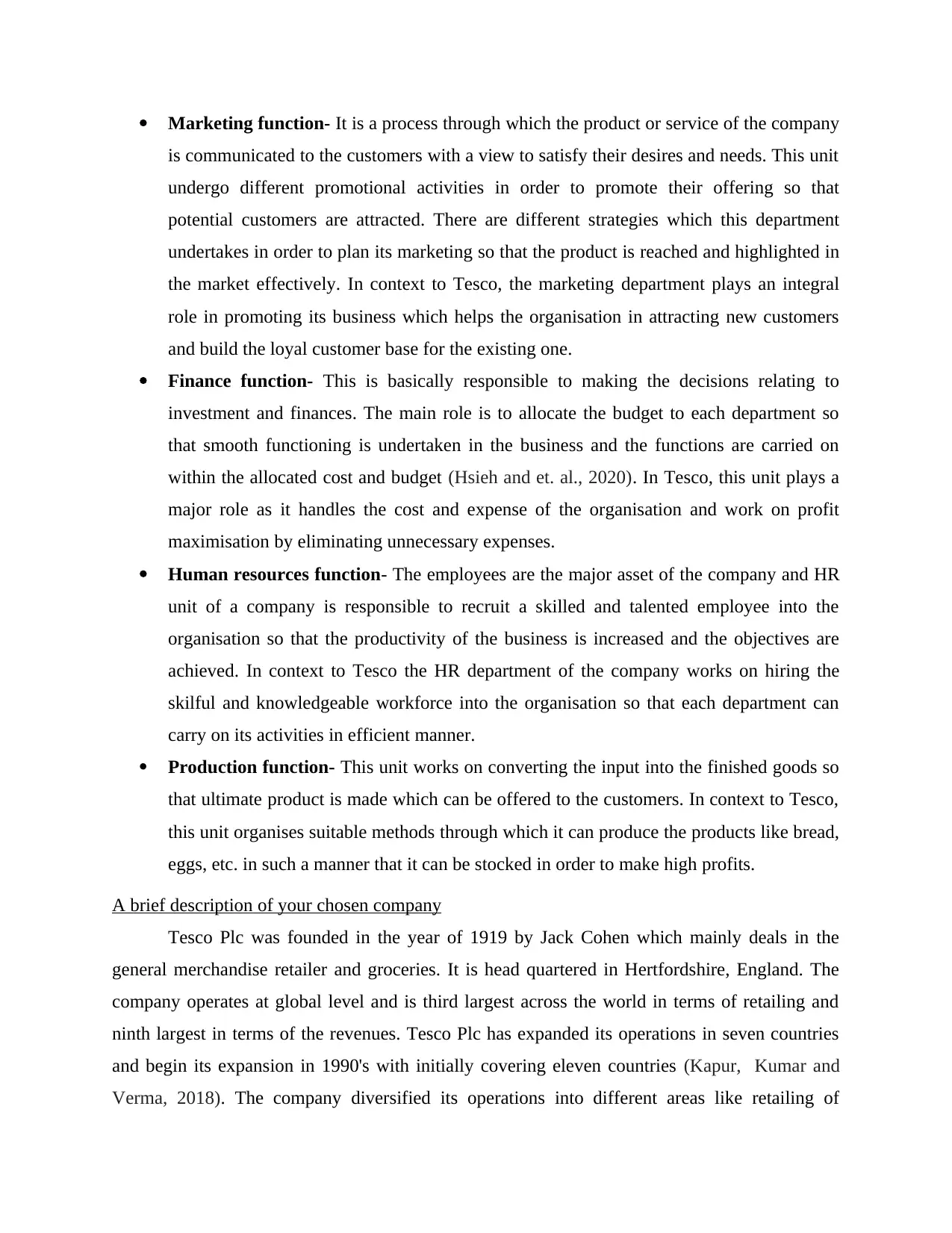
Marketing function- It is a process through which the product or service of the company
is communicated to the customers with a view to satisfy their desires and needs. This unit
undergo different promotional activities in order to promote their offering so that
potential customers are attracted. There are different strategies which this department
undertakes in order to plan its marketing so that the product is reached and highlighted in
the market effectively. In context to Tesco, the marketing department plays an integral
role in promoting its business which helps the organisation in attracting new customers
and build the loyal customer base for the existing one.
Finance function- This is basically responsible to making the decisions relating to
investment and finances. The main role is to allocate the budget to each department so
that smooth functioning is undertaken in the business and the functions are carried on
within the allocated cost and budget (Hsieh and et. al., 2020). In Tesco, this unit plays a
major role as it handles the cost and expense of the organisation and work on profit
maximisation by eliminating unnecessary expenses.
Human resources function- The employees are the major asset of the company and HR
unit of a company is responsible to recruit a skilled and talented employee into the
organisation so that the productivity of the business is increased and the objectives are
achieved. In context to Tesco the HR department of the company works on hiring the
skilful and knowledgeable workforce into the organisation so that each department can
carry on its activities in efficient manner.
Production function- This unit works on converting the input into the finished goods so
that ultimate product is made which can be offered to the customers. In context to Tesco,
this unit organises suitable methods through which it can produce the products like bread,
eggs, etc. in such a manner that it can be stocked in order to make high profits.
A brief description of your chosen company
Tesco Plc was founded in the year of 1919 by Jack Cohen which mainly deals in the
general merchandise retailer and groceries. It is head quartered in Hertfordshire, England. The
company operates at global level and is third largest across the world in terms of retailing and
ninth largest in terms of the revenues. Tesco Plc has expanded its operations in seven countries
and begin its expansion in 1990's with initially covering eleven countries (Kapur, Kumar and
Verma, 2018). The company diversified its operations into different areas like retailing of
is communicated to the customers with a view to satisfy their desires and needs. This unit
undergo different promotional activities in order to promote their offering so that
potential customers are attracted. There are different strategies which this department
undertakes in order to plan its marketing so that the product is reached and highlighted in
the market effectively. In context to Tesco, the marketing department plays an integral
role in promoting its business which helps the organisation in attracting new customers
and build the loyal customer base for the existing one.
Finance function- This is basically responsible to making the decisions relating to
investment and finances. The main role is to allocate the budget to each department so
that smooth functioning is undertaken in the business and the functions are carried on
within the allocated cost and budget (Hsieh and et. al., 2020). In Tesco, this unit plays a
major role as it handles the cost and expense of the organisation and work on profit
maximisation by eliminating unnecessary expenses.
Human resources function- The employees are the major asset of the company and HR
unit of a company is responsible to recruit a skilled and talented employee into the
organisation so that the productivity of the business is increased and the objectives are
achieved. In context to Tesco the HR department of the company works on hiring the
skilful and knowledgeable workforce into the organisation so that each department can
carry on its activities in efficient manner.
Production function- This unit works on converting the input into the finished goods so
that ultimate product is made which can be offered to the customers. In context to Tesco,
this unit organises suitable methods through which it can produce the products like bread,
eggs, etc. in such a manner that it can be stocked in order to make high profits.
A brief description of your chosen company
Tesco Plc was founded in the year of 1919 by Jack Cohen which mainly deals in the
general merchandise retailer and groceries. It is head quartered in Hertfordshire, England. The
company operates at global level and is third largest across the world in terms of retailing and
ninth largest in terms of the revenues. Tesco Plc has expanded its operations in seven countries
and begin its expansion in 1990's with initially covering eleven countries (Kapur, Kumar and
Verma, 2018). The company diversified its operations into different areas like retailing of
Paraphrase This Document
Need a fresh take? Get an instant paraphrase of this document with our AI Paraphraser
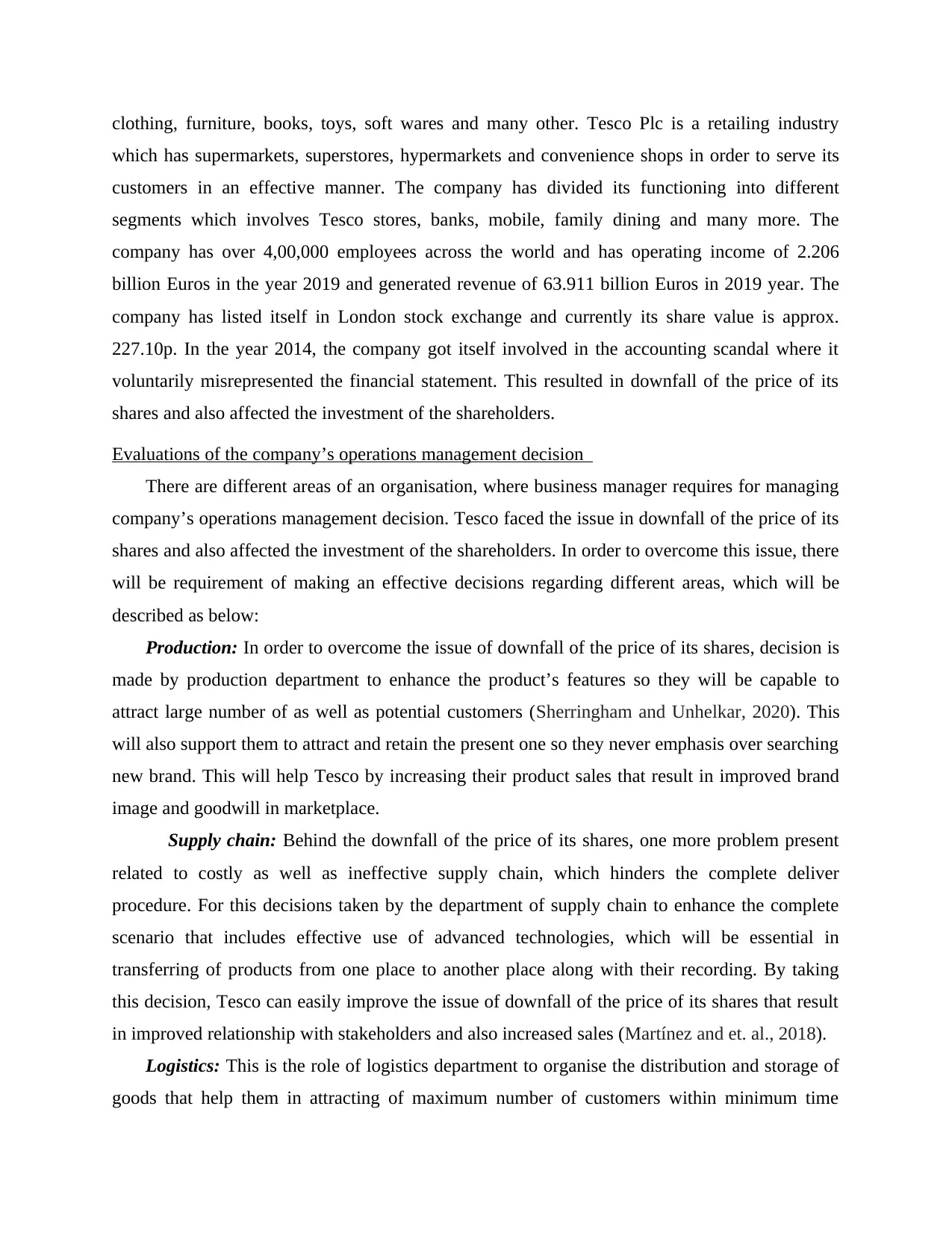
clothing, furniture, books, toys, soft wares and many other. Tesco Plc is a retailing industry
which has supermarkets, superstores, hypermarkets and convenience shops in order to serve its
customers in an effective manner. The company has divided its functioning into different
segments which involves Tesco stores, banks, mobile, family dining and many more. The
company has over 4,00,000 employees across the world and has operating income of 2.206
billion Euros in the year 2019 and generated revenue of 63.911 billion Euros in 2019 year. The
company has listed itself in London stock exchange and currently its share value is approx.
227.10p. In the year 2014, the company got itself involved in the accounting scandal where it
voluntarily misrepresented the financial statement. This resulted in downfall of the price of its
shares and also affected the investment of the shareholders.
Evaluations of the company’s operations management decision
There are different areas of an organisation, where business manager requires for managing
company’s operations management decision. Tesco faced the issue in downfall of the price of its
shares and also affected the investment of the shareholders. In order to overcome this issue, there
will be requirement of making an effective decisions regarding different areas, which will be
described as below:
Production: In order to overcome the issue of downfall of the price of its shares, decision is
made by production department to enhance the product’s features so they will be capable to
attract large number of as well as potential customers (Sherringham and Unhelkar, 2020). This
will also support them to attract and retain the present one so they never emphasis over searching
new brand. This will help Tesco by increasing their product sales that result in improved brand
image and goodwill in marketplace.
Supply chain: Behind the downfall of the price of its shares, one more problem present
related to costly as well as ineffective supply chain, which hinders the complete deliver
procedure. For this decisions taken by the department of supply chain to enhance the complete
scenario that includes effective use of advanced technologies, which will be essential in
transferring of products from one place to another place along with their recording. By taking
this decision, Tesco can easily improve the issue of downfall of the price of its shares that result
in improved relationship with stakeholders and also increased sales (Martínez and et. al., 2018).
Logistics: This is the role of logistics department to organise the distribution and storage of
goods that help them in attracting of maximum number of customers within minimum time
which has supermarkets, superstores, hypermarkets and convenience shops in order to serve its
customers in an effective manner. The company has divided its functioning into different
segments which involves Tesco stores, banks, mobile, family dining and many more. The
company has over 4,00,000 employees across the world and has operating income of 2.206
billion Euros in the year 2019 and generated revenue of 63.911 billion Euros in 2019 year. The
company has listed itself in London stock exchange and currently its share value is approx.
227.10p. In the year 2014, the company got itself involved in the accounting scandal where it
voluntarily misrepresented the financial statement. This resulted in downfall of the price of its
shares and also affected the investment of the shareholders.
Evaluations of the company’s operations management decision
There are different areas of an organisation, where business manager requires for managing
company’s operations management decision. Tesco faced the issue in downfall of the price of its
shares and also affected the investment of the shareholders. In order to overcome this issue, there
will be requirement of making an effective decisions regarding different areas, which will be
described as below:
Production: In order to overcome the issue of downfall of the price of its shares, decision is
made by production department to enhance the product’s features so they will be capable to
attract large number of as well as potential customers (Sherringham and Unhelkar, 2020). This
will also support them to attract and retain the present one so they never emphasis over searching
new brand. This will help Tesco by increasing their product sales that result in improved brand
image and goodwill in marketplace.
Supply chain: Behind the downfall of the price of its shares, one more problem present
related to costly as well as ineffective supply chain, which hinders the complete deliver
procedure. For this decisions taken by the department of supply chain to enhance the complete
scenario that includes effective use of advanced technologies, which will be essential in
transferring of products from one place to another place along with their recording. By taking
this decision, Tesco can easily improve the issue of downfall of the price of its shares that result
in improved relationship with stakeholders and also increased sales (Martínez and et. al., 2018).
Logistics: This is the role of logistics department to organise the distribution and storage of
goods that help them in attracting of maximum number of customers within minimum time
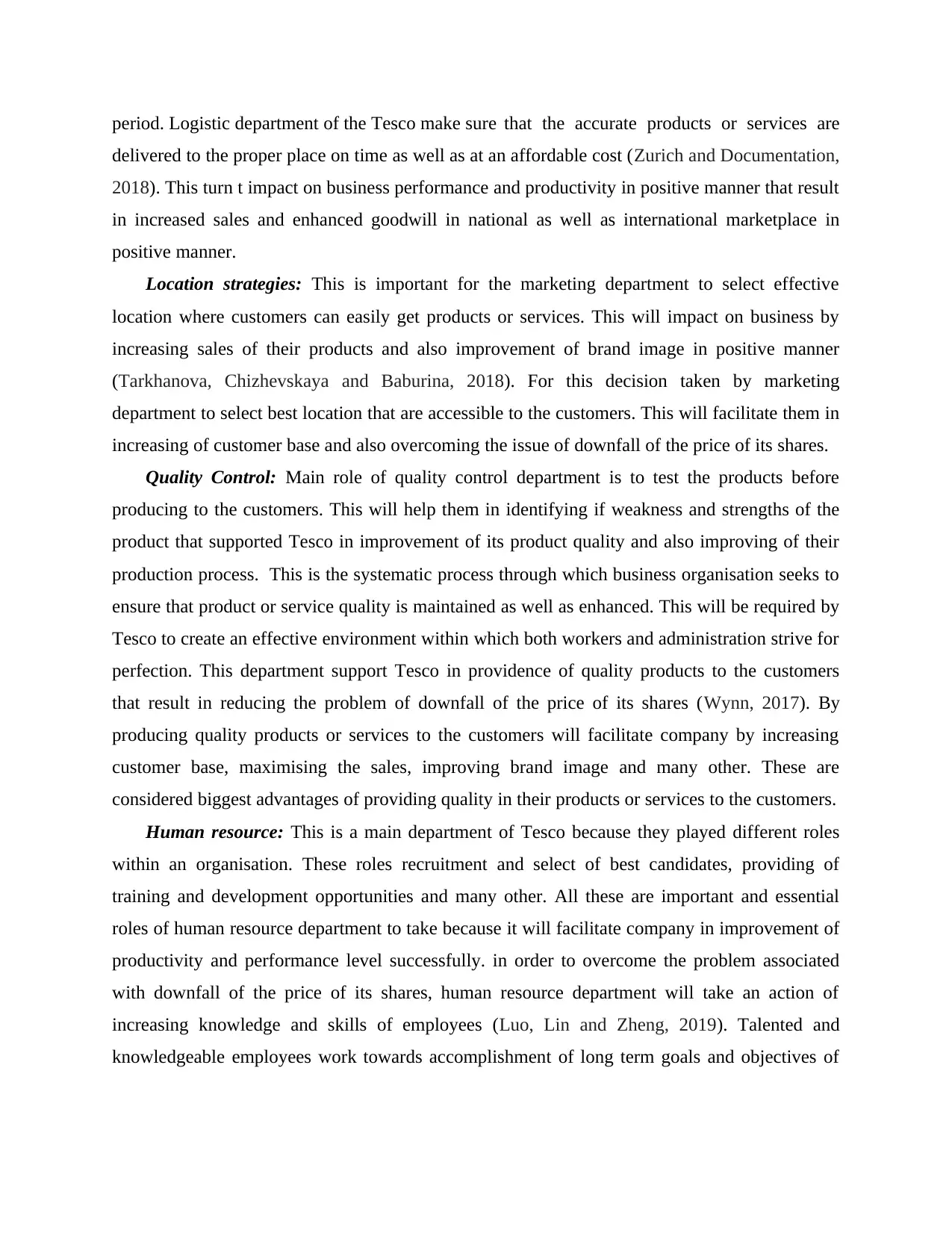
period. Logistic department of the Tesco make sure that the accurate products or services are
delivered to the proper place on time as well as at an affordable cost (Zurich and Documentation,
2018). This turn t impact on business performance and productivity in positive manner that result
in increased sales and enhanced goodwill in national as well as international marketplace in
positive manner.
Location strategies: This is important for the marketing department to select effective
location where customers can easily get products or services. This will impact on business by
increasing sales of their products and also improvement of brand image in positive manner
(Tarkhanova, Chizhevskaya and Baburina, 2018). For this decision taken by marketing
department to select best location that are accessible to the customers. This will facilitate them in
increasing of customer base and also overcoming the issue of downfall of the price of its shares.
Quality Control: Main role of quality control department is to test the products before
producing to the customers. This will help them in identifying if weakness and strengths of the
product that supported Tesco in improvement of its product quality and also improving of their
production process. This is the systematic process through which business organisation seeks to
ensure that product or service quality is maintained as well as enhanced. This will be required by
Tesco to create an effective environment within which both workers and administration strive for
perfection. This department support Tesco in providence of quality products to the customers
that result in reducing the problem of downfall of the price of its shares (Wynn, 2017). By
producing quality products or services to the customers will facilitate company by increasing
customer base, maximising the sales, improving brand image and many other. These are
considered biggest advantages of providing quality in their products or services to the customers.
Human resource: This is a main department of Tesco because they played different roles
within an organisation. These roles recruitment and select of best candidates, providing of
training and development opportunities and many other. All these are important and essential
roles of human resource department to take because it will facilitate company in improvement of
productivity and performance level successfully. in order to overcome the problem associated
with downfall of the price of its shares, human resource department will take an action of
increasing knowledge and skills of employees (Luo, Lin and Zheng, 2019). Talented and
knowledgeable employees work towards accomplishment of long term goals and objectives of
delivered to the proper place on time as well as at an affordable cost (Zurich and Documentation,
2018). This turn t impact on business performance and productivity in positive manner that result
in increased sales and enhanced goodwill in national as well as international marketplace in
positive manner.
Location strategies: This is important for the marketing department to select effective
location where customers can easily get products or services. This will impact on business by
increasing sales of their products and also improvement of brand image in positive manner
(Tarkhanova, Chizhevskaya and Baburina, 2018). For this decision taken by marketing
department to select best location that are accessible to the customers. This will facilitate them in
increasing of customer base and also overcoming the issue of downfall of the price of its shares.
Quality Control: Main role of quality control department is to test the products before
producing to the customers. This will help them in identifying if weakness and strengths of the
product that supported Tesco in improvement of its product quality and also improving of their
production process. This is the systematic process through which business organisation seeks to
ensure that product or service quality is maintained as well as enhanced. This will be required by
Tesco to create an effective environment within which both workers and administration strive for
perfection. This department support Tesco in providence of quality products to the customers
that result in reducing the problem of downfall of the price of its shares (Wynn, 2017). By
producing quality products or services to the customers will facilitate company by increasing
customer base, maximising the sales, improving brand image and many other. These are
considered biggest advantages of providing quality in their products or services to the customers.
Human resource: This is a main department of Tesco because they played different roles
within an organisation. These roles recruitment and select of best candidates, providing of
training and development opportunities and many other. All these are important and essential
roles of human resource department to take because it will facilitate company in improvement of
productivity and performance level successfully. in order to overcome the problem associated
with downfall of the price of its shares, human resource department will take an action of
increasing knowledge and skills of employees (Luo, Lin and Zheng, 2019). Talented and
knowledgeable employees work towards accomplishment of long term goals and objectives of
⊘ This is a preview!⊘
Do you want full access?
Subscribe today to unlock all pages.

Trusted by 1+ million students worldwide
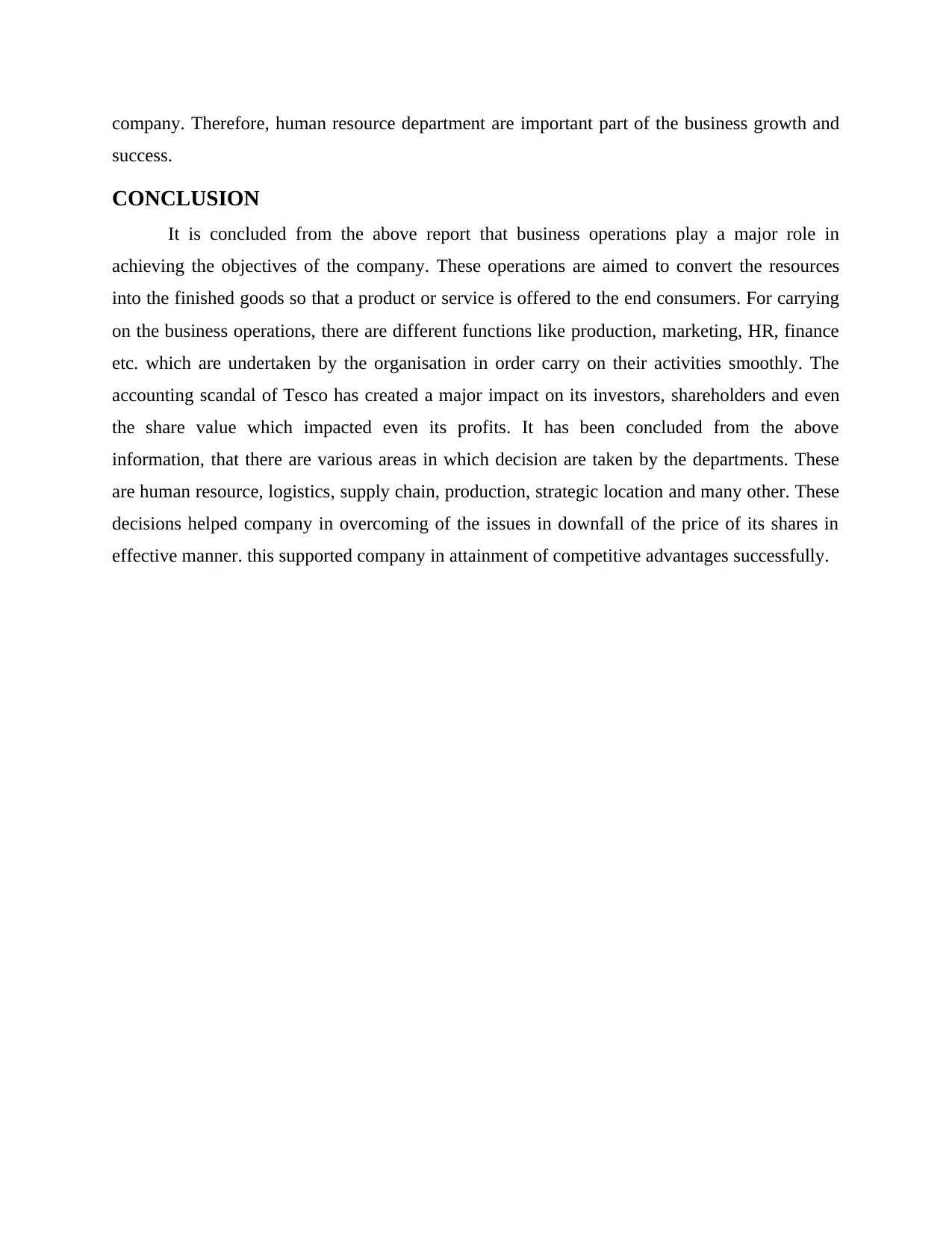
company. Therefore, human resource department are important part of the business growth and
success.
CONCLUSION
It is concluded from the above report that business operations play a major role in
achieving the objectives of the company. These operations are aimed to convert the resources
into the finished goods so that a product or service is offered to the end consumers. For carrying
on the business operations, there are different functions like production, marketing, HR, finance
etc. which are undertaken by the organisation in order carry on their activities smoothly. The
accounting scandal of Tesco has created a major impact on its investors, shareholders and even
the share value which impacted even its profits. It has been concluded from the above
information, that there are various areas in which decision are taken by the departments. These
are human resource, logistics, supply chain, production, strategic location and many other. These
decisions helped company in overcoming of the issues in downfall of the price of its shares in
effective manner. this supported company in attainment of competitive advantages successfully.
success.
CONCLUSION
It is concluded from the above report that business operations play a major role in
achieving the objectives of the company. These operations are aimed to convert the resources
into the finished goods so that a product or service is offered to the end consumers. For carrying
on the business operations, there are different functions like production, marketing, HR, finance
etc. which are undertaken by the organisation in order carry on their activities smoothly. The
accounting scandal of Tesco has created a major impact on its investors, shareholders and even
the share value which impacted even its profits. It has been concluded from the above
information, that there are various areas in which decision are taken by the departments. These
are human resource, logistics, supply chain, production, strategic location and many other. These
decisions helped company in overcoming of the issues in downfall of the price of its shares in
effective manner. this supported company in attainment of competitive advantages successfully.
Paraphrase This Document
Need a fresh take? Get an instant paraphrase of this document with our AI Paraphraser
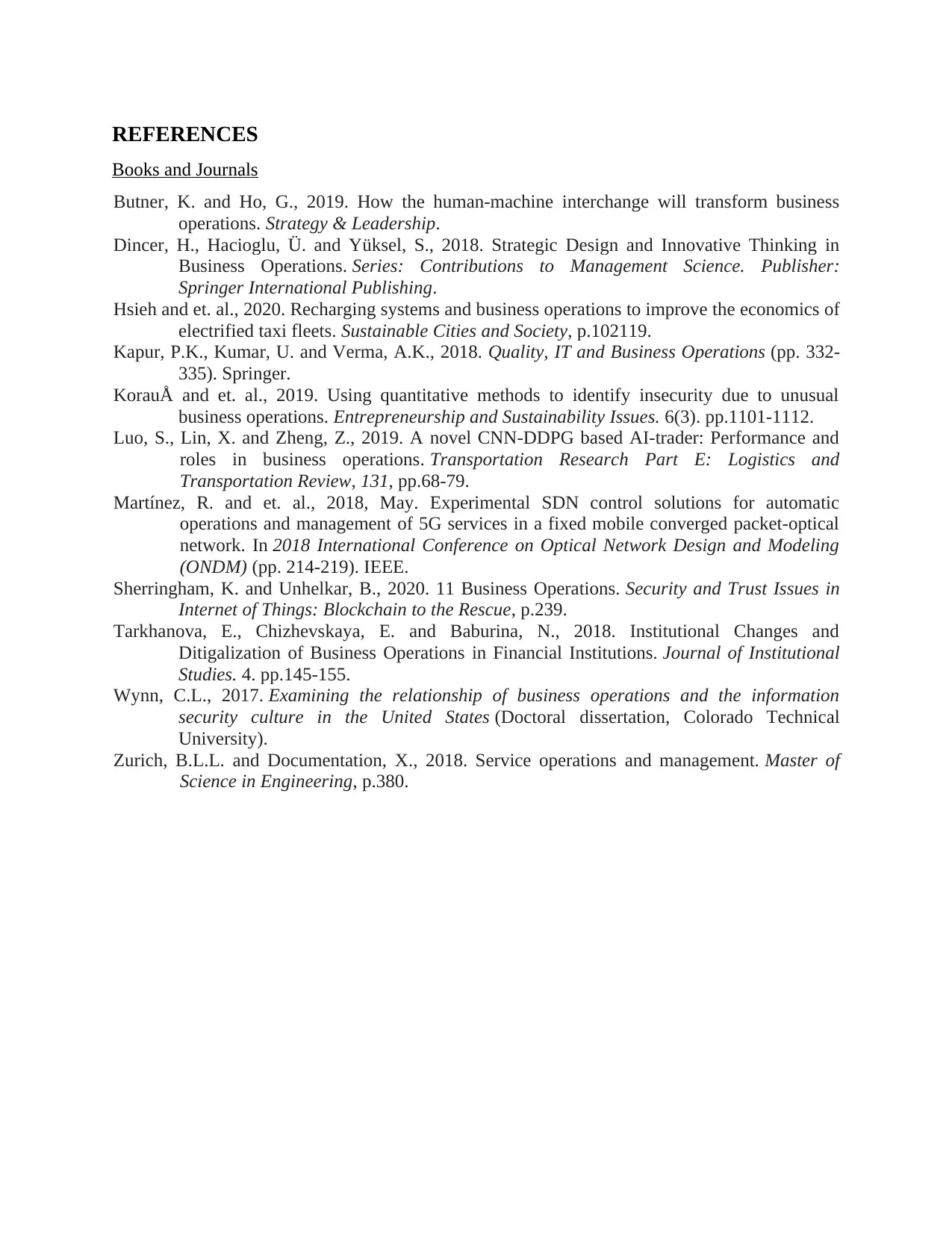
REFERENCES
Books and Journals
Butner, K. and Ho, G., 2019. How the human-machine interchange will transform business
operations. Strategy & Leadership.
Dincer, H., Hacioglu, Ü. and Yüksel, S., 2018. Strategic Design and Innovative Thinking in
Business Operations. Series: Contributions to Management Science. Publisher:
Springer International Publishing.
Hsieh and et. al., 2020. Recharging systems and business operations to improve the economics of
electrified taxi fleets. Sustainable Cities and Society, p.102119.
Kapur, P.K., Kumar, U. and Verma, A.K., 2018. Quality, IT and Business Operations (pp. 332-
335). Springer.
KorauÅ and et. al., 2019. Using quantitative methods to identify insecurity due to unusual
business operations. Entrepreneurship and Sustainability Issues. 6(3). pp.1101-1112.
Luo, S., Lin, X. and Zheng, Z., 2019. A novel CNN-DDPG based AI-trader: Performance and
roles in business operations. Transportation Research Part E: Logistics and
Transportation Review, 131, pp.68-79.
Martínez, R. and et. al., 2018, May. Experimental SDN control solutions for automatic
operations and management of 5G services in a fixed mobile converged packet-optical
network. In 2018 International Conference on Optical Network Design and Modeling
(ONDM) (pp. 214-219). IEEE.
Sherringham, K. and Unhelkar, B., 2020. 11 Business Operations. Security and Trust Issues in
Internet of Things: Blockchain to the Rescue, p.239.
Tarkhanova, E., Chizhevskaya, E. and Baburina, N., 2018. Institutional Changes and
Ditigalization of Business Operations in Financial Institutions. Journal of Institutional
Studies. 4. pp.145-155.
Wynn, C.L., 2017. Examining the relationship of business operations and the information
security culture in the United States (Doctoral dissertation, Colorado Technical
University).
Zurich, B.L.L. and Documentation, X., 2018. Service operations and management. Master of
Science in Engineering, p.380.
Books and Journals
Butner, K. and Ho, G., 2019. How the human-machine interchange will transform business
operations. Strategy & Leadership.
Dincer, H., Hacioglu, Ü. and Yüksel, S., 2018. Strategic Design and Innovative Thinking in
Business Operations. Series: Contributions to Management Science. Publisher:
Springer International Publishing.
Hsieh and et. al., 2020. Recharging systems and business operations to improve the economics of
electrified taxi fleets. Sustainable Cities and Society, p.102119.
Kapur, P.K., Kumar, U. and Verma, A.K., 2018. Quality, IT and Business Operations (pp. 332-
335). Springer.
KorauÅ and et. al., 2019. Using quantitative methods to identify insecurity due to unusual
business operations. Entrepreneurship and Sustainability Issues. 6(3). pp.1101-1112.
Luo, S., Lin, X. and Zheng, Z., 2019. A novel CNN-DDPG based AI-trader: Performance and
roles in business operations. Transportation Research Part E: Logistics and
Transportation Review, 131, pp.68-79.
Martínez, R. and et. al., 2018, May. Experimental SDN control solutions for automatic
operations and management of 5G services in a fixed mobile converged packet-optical
network. In 2018 International Conference on Optical Network Design and Modeling
(ONDM) (pp. 214-219). IEEE.
Sherringham, K. and Unhelkar, B., 2020. 11 Business Operations. Security and Trust Issues in
Internet of Things: Blockchain to the Rescue, p.239.
Tarkhanova, E., Chizhevskaya, E. and Baburina, N., 2018. Institutional Changes and
Ditigalization of Business Operations in Financial Institutions. Journal of Institutional
Studies. 4. pp.145-155.
Wynn, C.L., 2017. Examining the relationship of business operations and the information
security culture in the United States (Doctoral dissertation, Colorado Technical
University).
Zurich, B.L.L. and Documentation, X., 2018. Service operations and management. Master of
Science in Engineering, p.380.
1 out of 8
Related Documents
Your All-in-One AI-Powered Toolkit for Academic Success.
+13062052269
info@desklib.com
Available 24*7 on WhatsApp / Email
![[object Object]](/_next/static/media/star-bottom.7253800d.svg)
Unlock your academic potential
Copyright © 2020–2025 A2Z Services. All Rights Reserved. Developed and managed by ZUCOL.





